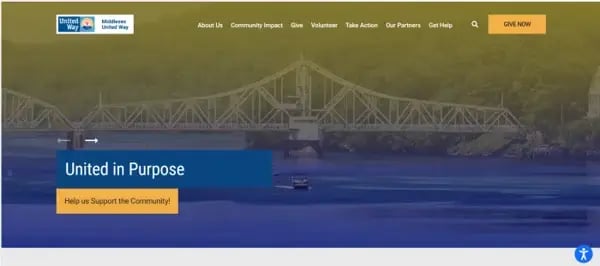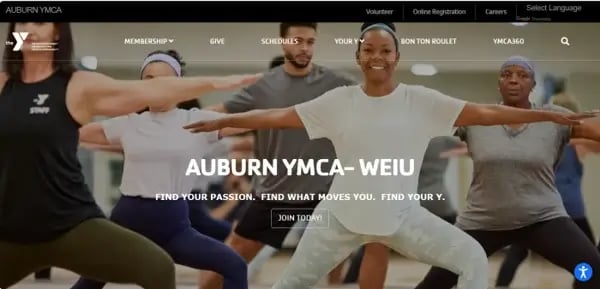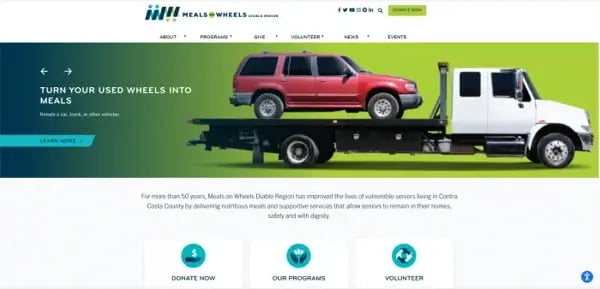In this digital age where information is just a click away, the importance - and ADA requirements - of website accessibility cannot be overstated. For nonprofits, whose mission is often centered around inclusivity and social impact, ensuring that your online presence is accessible to all is not just a good practice—it's a necessity.
A Brief Overview of the Importance of Website Accessibility for Nonprofits
Picture this: an individual with visual impairments is trying to access crucial information about your nonprofit's upcoming events or donation opportunities. If your website is not designed with accessibility in mind, this person may encounter barriers that hinder their ability to engage with your organization. Website accessibility goes beyond just accommodating individuals with disabilities. It's about creating an inclusive digital space where everyone, regardless of their abilities, can access and navigate your content seamlessly.
If you’re like most nonprofits, you rely heavily on your website to communicate your mission, share success stories, and mobilize support. By prioritizing accessibility, your organization can broaden your reach and make a more significant impact. Also, accessibility is not only a moral imperative but also a legal requirement, as failure to comply with accessibility standards can result in legal consequences.
The Connection Between ADA Compliance and Success
The Americans with Disabilities Act (ADA) is a landmark legislation that prohibits discrimination against individuals with disabilities in various areas, including public accommodations and services. In the digital realm, this extends to websites, making ADA compliance a crucial factor for nonprofits.
Achieving ADA compliance isn't just about avoiding legal repercussions. It's a strategic move that can directly contribute to the success of your nonprofit. When your website is accessible, it opens the doors to a broader audience, including individuals with disabilities who may become donors, volunteers, or advocates. And, an ADA-compliant website enhances the overall user experience, making it more user-friendly for everyone, regardless of their abilities.
The Impact of Website Accessibility
 Ensuring that your nonprofit's website is accessible goes beyond just compliance. It transforms the user experience for everyone involved, leaving a lasting impact on both your audience and the organization itself.
Ensuring that your nonprofit's website is accessible goes beyond just compliance. It transforms the user experience for everyone involved, leaving a lasting impact on both your audience and the organization itself.
Improving User Experience for All Visitors
Website accessibility is not just a feature for a specific group; it's a universal enhancement that benefits every visitor. Consider the scenario of a user navigating your site using only a keyboard or a screen reader. An accessible design ensures that these users can effortlessly move through your content, making their journey seamless and enjoyable.
But it's not just about catering to specific needs. It's also about creating a website that is inherently user-friendly. Elements like clear navigation, well-structured content, and easily distinguishable links, which are essential for accessibility, also contribute to an overall positive experience for every visitor.
By prioritizing accessibility, you are investing in a website that is intuitive, easy to navigate, and welcoming to a diverse audience. This not only fosters a positive perception of your nonprofit but also encourages visitors to spend more time exploring your mission, impact stories, and opportunities for engagement.
Broadening Reach and Audience Engagement
One of the key advantages of an accessible website is its ability to reach a wider audience. Accessibility is not limited to specific demographics. It is also a way to connect with individuals of varying abilities, backgrounds, and preferences.
Consider the potential supporters who may have disabilities but are passionate about your cause. An accessible website ensures these individuals can fully engage with your content, participate in campaigns, and contribute to your organization. It broadens your reach by tapping into a pool of supporters who might otherwise be excluded. Additionally, an inclusive online presence fosters a sense of community and belonging. When visitors feel that your nonprofit values accessibility, they are more likely to become long-term advocates, donors, or volunteers. Accessibility becomes a statement about your commitment to inclusivity, echoing your organization's dedication to creating a positive impact for everyone.
Building Trust and Credibility
In the nonprofit sector, trust is the currency that drives support. An accessible website not only demonstrates a commitment to inclusivity but also builds trust among your audience. When users, regardless of their abilities, find that your organization has taken the extra step to ensure accessibility, it sends a powerful message about transparency and accountability. This commitment to inclusivity fosters credibility, making visitors more likely to engage, support, and champion your cause. In the digital landscape where first impressions matter, a website that prioritizes accessibility becomes a cornerstone of trust, laying the foundation for meaningful connections and sustained impact.
Legal Implications of ADA Compliance
Navigating the digital landscape isn't just about creating an engaging and accessible website for your nonprofit. It's also about understanding and adhering to legal standards set forth by the Americans with Disabilities Act (ADA). In this section, we'll explore the essential components of ADA requirements for websites and the potential consequences that may arise from non-compliance.
Overview of ADA Requirements for Websites
The Americans with Disabilities Act extends its reach into the digital realm, making it crucial for nonprofits to ensure their websites are accessible to individuals with disabilities. The ADA doesn't provide specific guidelines for website design, but it references the Web Content Accessibility Guidelines (WCAG), which offer a comprehensive framework for creating accessible web content.
Key ADA requirements for websites include providing alternative (ALT) text for images, ensuring compatibility with screen readers, implementing keyboard navigation, and offering text alternatives for non-text content. Compliance with these standards is not just a legal obligation; it's a commitment to inclusivity and equal access to information.
Potential Consequences of Non-Compliance
 The consequences of non-compliance with ADA standards for websites can be significant, both legally and reputationally. Legal actions against nonprofits that fail to meet ADA requirements have become more prevalent, with individuals and advocacy groups taking legal steps to enforce digital accessibility.
The consequences of non-compliance with ADA standards for websites can be significant, both legally and reputationally. Legal actions against nonprofits that fail to meet ADA requirements have become more prevalent, with individuals and advocacy groups taking legal steps to enforce digital accessibility.
Nonprofit organizations found guilty of ADA violations may face financial penalties, legal fees, and court-ordered compliance measures. Beyond the immediate legal consequences, the damage to the organization's reputation can be lasting. Today where information spreads rapidly, news of non-compliance can erode trust among supporters, donors, and the broader community.
Additionally, accessibility is not just a legal checkbox—it's a fundamental aspect of ethical and responsible digital engagement. Nonprofits that prioritize accessibility demonstrate a commitment to their mission of inclusivity and equality, contributing to a positive public perception.
In the next segment, we will dive into practical steps and strategies for achieving ADA compliance, empowering your nonprofit to not only meet legal standards but also to create a digital space that reflects your dedication to accessibility and social impact.
Steps to Achieve ADA Compliance
Ensuring your nonprofit's website aligns with ADA standards isn't just a legal obligation. It's a strategic move toward creating a more inclusive and impactful online presence. In this section, we'll guide you through the essential steps to achieve ADA compliance.
Conducting an Accessibility Audit
Starting on the journey to ADA compliance begins with a thorough accessibility audit. This involves assessing your website's current state of accessibility by examining its design, structure, and content against the Web Content Accessibility Guidelines (WCAG). OneEach can conduct a website accessibility scan and findings report for you at no charge. Request your scan here.
Our website accessibility scan will look at elements such as alternative text for images, keyboard navigation, color contrast, and compatibility with screen readers. The report will identify areas that may pose barriers to users with disabilities and make note of necessary improvements.
Implementing Necessary Changes and Improvements
Once the website accessibility scan is complete, it's time to implement the recommended changes and improvements. We will discuss your options in the complimentary follow-up consultation. This phase may involve working with our seasoned web developers, designers, and content creators to address specific issues identified in the accessibility scan.
It’s important to prioritize the fixes based on their impact on user experience and legal compliance. This may include adding alternative text to images, ensuring proper heading structures, enabling keyboard navigation, and optimizing forms for screen readers. The OneEach team is available to collaborate with you to integrate accessibility features seamlessly into your website's design and functionality.
Consider involving individuals with disabilities in the testing phase to gather valuable feedback on the user experience. This user-centered approach ensures that your website is not only technically compliant but also genuinely accessible and user-friendly.
Ongoing Monitoring and Updates
Achieving ADA compliance is not a one-time effort—it's an ongoing commitment. Regularly monitor and assess your website's accessibility, especially when making updates or adding new content. Technology evolves, and web standards may change, so staying vigilant is crucial to maintaining compliance.
Establish a process for ongoing monitoring, which may include periodic accessibility audits, user testing, and staying informed about the latest developments in web accessibility. Encourage a culture of accessibility within your organization, ensuring that all team members are aware of the importance of maintaining an inclusive digital space.
By incorporating these steps into your nonprofit's digital strategy, you not only fulfill legal obligations but also contribute to a more accessible and welcoming online environment. And here's a bonus - accessibility improves your SEO ranking!
In our next segment, we'll explore real-world examples of a few of our nonprofit customers who have successfully achieved ADA compliance, showcasing the positive impact of an inclusive digital presence.
Success Stories: Nonprofits Thriving with ADA-Compliant Websites
In the realm of digital transformation, nonprofits are discovering that ADA compliance isn't just a legal requirement—it's a catalyst for success and expanded impact. Let's explore real-world examples of nonprofits that are OneEach customers that have embraced accessibility and witnessed tangible benefits. And, they all receive 100% ADA compliance in the following areas of our website accessibility scan:
- clickables
- titles
- orientation
- graphics
- forms
- document
- readability
- other general items such as including a web accessibility interface and iframe elements should be labeled or titled
Middlesex United Way

Middlesex United Way, located in Middletown, CT, has been a OneEach customer since 2010. We built their website using a branded, designed United Way theme on Drupal 9 with the added website accessibility tools. Check out Middlesex United Way's beautiful, and accessible, website.
Valley Program for Aging Services
.webp?width=600&height=288&name=VPAS-Homepage-1%20(1).webp)
Valley Program for Aging Services, located in Harrisonburg, VA, has been a OneEach customer since 2015. We built their custom website on Drupal 9 with the added website accessibility tools. Check out the beautiful Valley Program for Aging Services site.
Auburn YMCA

Auburn YMCA, located in Auburn, NY, has been a OneEach customer since 2019. We built their branded YMCA site on Drupal 9 with the added website accessibility tools. Check out the beautiful Auburn YMCA site .
Meals On Wheels Diablo Region

Meals On Wheels Diablo Region, located in Walnut Creek, CA, has been a OneEach customer since 2017. We built their branded Meals on Wheels site on Drupal 9 with the added website accessibility tools. Check out the beautiful Meals on Wheels Diablo Region site.
OneEach Accessibility Tool for Nonprofits
Navigating the landscape of website accessibility can be a daunting task, but fortunately, OneEach offers an AI-powered web accessibility tool that is ADA, AODA, EAA, and WCAG compliant to support nonprofits on their journey toward digital inclusivity.
AI Scanning of Your Website
Our AI-powered process handles the more complex and majority of accessibility requirements. The AI scans and analyzes your website using a contextual understanding process. It learns the purpose and function of every element before fixing it. Pop-ups, drop-downs, forms, validations, menus, links, and buttons are all included.
User Choices to Enhance Website Accessibility
Here are some of the choices that visitors to your website can select for their individual accessibility needs.
- Accessibility profile. Choices include Seizure Safe, Vision Impaired, ADHD Friendly, Cognitive Disability, Keyboard Navigation, and Blind Users.
- Content adjustments. Choices include Content Scaling, Readable Font, Highlight Titles, Highlight Links, Text Magnifier, Font Sizing, Font Alignment, Line Height, and Letter Spacing.
- Color Adjustments. Choices include Dark/Light/High Contrast, High/Low Saturation, Monochrome, and Text/Title/Background Colors.
- Orientation Adjustments. Choices include Mute Sounds, Hide Images, Read Mode, Reading Guide, Stop Animations, Reading Mask, Highlight Hover/Focus, Big Black/White Cursor
By leveraging these tools, your nonprofit can empower your team to assess, enhance, and maintain website accessibility. Whether you're just starting the journey or looking to refine your existing practices, these OneEach tools can be invaluable allies in your commitment to creating an inclusive online space.
Ready to learn more? Sign up for your free website accessibility scan and consultation today!
In our final section, we'll explore the long-term benefits of maintaining accessibility excellence and the positive impact it can have on your nonprofit's mission.
Conclusion
As we conclude our exploration of website accessibility for nonprofits, it's crucial to reflect on the significance of ADA compliance and the lasting impact it can have on your organization's success.
Recap of the Importance of ADA Compliance for Nonprofit Success
Website accessibility isn't just a checkbox on a legal compliance list; it's a fundamental aspect of creating an inclusive and impactful online presence. By aligning with the Americans with Disabilities Act (ADA) and adhering to standards like the Web Content Accessibility Guidelines (WCAG), your nonprofit can break down digital barriers and reach a broader audience. From improved user experiences to building trust and credibility, the benefits of ADA compliance extend far beyond legal requirements.
Ensuring that your website is accessible to individuals with disabilities is not only a moral imperative but a strategic move that positions your nonprofit for long-term success. It opens the doors to a more engaged and diverse audience, fostering a sense of community and support around your mission.
Encouragement for Nonprofits to Prioritize Accessibility for Long-Term Impact
If you're just starting out or continuing your journey toward accessibility excellence, remember that the impact goes beyond immediate outcomes. Prioritizing accessibility is an investment in your nonprofit's long-term success and sustainability. It's a commitment to inclusivity, equality, and social impact.
Encourage a culture of accessibility within your organization, involving all team members in the process. Embrace the tools and resources available to assess, enhance, and maintain website accessibility. As technology evolves, so should your commitment to creating a digital space that welcomes everyone, regardless of their abilities.
By making accessibility a core tenet of your digital strategy, you not only comply with legal standards but also contribute to a more equitable and supportive online environment. The positive outcomes, from increased engagement to strengthened donor relationships, are markers of a nonprofit that values accessibility as a cornerstone of its mission.
In the dynamic landscape of digital communication, accessibility isn't just a feature—it's a transformative force that shapes the narrative of your organization. As you continue on your journey, remember that each step toward accessibility is a step toward a future where your nonprofit's impact knows no boundaries. Embrace the power of inclusivity, and watch as your mission resonates with a wider, more diverse audience.
Thank you for joining us on this exploration of website accessibility for nonprofits. May your commitment to inclusivity pave the way for a future where every supporter, regardless of their abilities, can engage wholeheartedly with your organization's mission.
Ready to get started? Request your website accessibility scan today!
